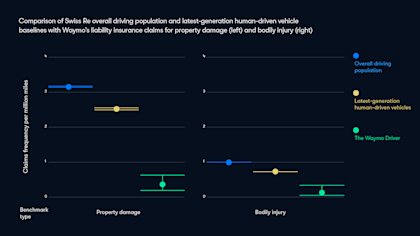December 19, 2024
New Swiss Re study: Waymo is safer than even the most advanced human-driven vehicles

Today, we’re sharing our new cutting-edge research with Swiss Re, one of the world’s leading reinsurers, analyzing liability claims related to collisions from 25.3 million fully autonomous miles driven by Waymo. The study uses auto liability claims aggregate statistics as a proxy for at-fault collisions and expands on our previous research. It demonstrates that as we've scaled operations across Phoenix, San Francisco, Los Angeles, and Austin, the Waymo Driver significantly outperforms both the overall driving population and the latest generation of human-driven vehicles equipped with advanced driver assistance systems (ADAS).
The study compared Waymo’s liability claims to human driver baselines, which are based on Swiss Re’s data from over 500,000 claims and over 200 billion miles of exposure. It found that the Waymo Driver demonstrated better safety performance when compared to human-driven vehicles, with an 88% reduction in property damage claims and 92% reduction in bodily injury claims. In real numbers, across 25.3 million miles, the Waymo Driver was involved in just nine property damage claims and two bodily injury claims. Both bodily injury claims are still open and described in the paper. For the same distance, human drivers would be expected to have 78 property damage and 26 bodily injury claims.
Notably, the Waymo Driver's safety advantages hold true even when compared to newer vehicles (2018-2021 models) equipped with modern safety technology. This includes advanced driver assistance systems (ADAS) such as automated emergency braking, forward collision warning, lane keeping assistance, and blind spot warning. When compared to this group, the Waymo Driver showed an 86% reduction in property damage claims and 90% reduction in bodily injury claims.

This analysis complements our safety impact data, which indicates that over 25 million fully autonomous miles, the Waymo Driver had fewer serious collisions than human drivers, independent of who was at fault. This Swiss Re study provides robust evidence that Waymo had no responsibility in the vast majority of the collisions its vehicles were involved in.
“Auto insurance claims data, traditionally used to assess human driver liability and risk, is a powerful tool in evaluating the safety performance of autonomous vehicles,” said Mauricio Peña, Chief Safety Officer at Waymo. “This is a truly groundbreaking study that not only validates the Waymo Driver’s strong safety record, but also provides a scalable framework for ongoing assessment of the impact autonomous vehicles make on road safety.”
"Our research shows how insurance data can help evaluate autonomous vehicle safety and provide the framework needed to support widespread adoption,” said Ali Shahkarami, Global Head P&C Solutions at Swiss Re. “By analyzing a larger dataset across multiple cities, we deepened our understanding of how this technology performs in real-world conditions. These promising results help underscore the potential of this technology to create a safer future for our roads."
This Swiss Re study provides valuable insights for the broader insurance industry. “It is great to see Waymo placing such an emphasis on the importance of public acceptance of Autonomous Driving System technology, and we agree this can only be achieved through education and the sharing of data,” said Chris Moore, President of Apollo ibott, a Lloyd’s of London Syndicate. “This particular report provided a staggering benchmark in a 90% lower claims frequency compared to human driving of newer vehicles with the most advanced driving assistance technology. We highly commend Waymo for this work and look forward to future study releases as we continue to move to an autonomous future of transportation.”
We're proud to share these results as part of our ongoing commitment to transparency and rigorous evaluation. As we continue to expand operations and bring the benefits of autonomous driving to more communities, we remain focused on our mission of improving transportation safety and mobility for everyone.
The paper has been submitted to a scientific journal, and the pre-print is available here.

